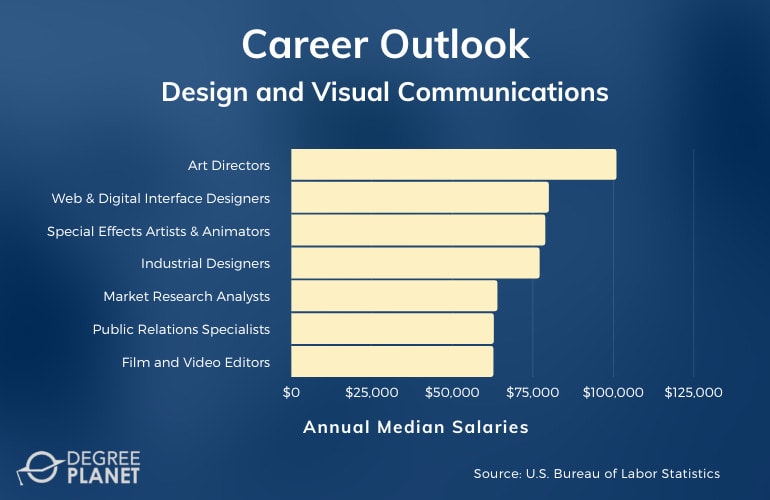A visual communications degree can push you to advance your creative craft and can expose you to a variety of platforms and styles, from traditional design to emerging media.

You can develop your artistic taste, practice industry-level techniques, and hone your innovative thinking to come up with design solutions.
Editorial Listing ShortCode:
After all, so many promising fields hinge on visual communication, including technology, marketing, and content creation. By studying visual communication, you could emerge with industry-ready skills that are applicable across various sectors.
Online Bachelors in Visual Communications Degrees

Visual communication is all about expressing information and ideas clearly through graphics, utilizing elements such as symbols, images, colors, fonts, and motion. It’s an incredibly broad field that covers the following:
- Graphic design
- Painting
- Illustration
- Video production
- Animation
- Virtual reality design
- Photography
- Advertising
- Data visualization
- Branding
- Fashion styling
- Visual merchandising
- Interaction design
- Game design
A visual communication degree can help prepare you to become a professional creative. Compared to more specialized programs, such as graphic design or animation, a bachelor’s degree in visual communication is much more versatile. It gives you exposure to several areas of media and design while letting you choose a specialization.
Editorial Listing ShortCode:
Since technology is constantly evolving, studying visual communication can make you adept at working with different kinds of media and keeping up with fast changes in the industry. After all, whatever platforms and tools you’ll be using, the standards for good visual communication—such as usability and beauty—still apply.
Because of this, you can expect a visual communication program to feature diverse art and design classes, with plenty of time spent on hands-on projects. At the same time, you’ll study communication theories, advertising, and problem-solving. In general, you’ll be trained to create media and develop a unique style while being mindful of your audience.
The program immerses you in the end-to-end design process, including working with clients, developing concepts, setting goals and budgets, and presenting the finished product. You can also learn the business fundamentals of design studios.
Graduates will have their own portfolio featuring diverse projects that they can show to potential employers. Since the program is well-rounded, many career paths are compatible with a visual communication degree. This includes most careers in print, digital, and motion design as well as media and advertising.
Design and Visual Communications Careers & Salaries

A visual communication degree can be applied to diverse career paths, to the point that most programs offer concentrations based on the career you’re interested in.
Visual communication majors traditionally end up in creative roles. Many specialize in graphic design and illustration, which involve creating visual assets such as posters, packaging, magazine art, brand guides, and publishing layouts.
Graphic designers and illustrators may work for design studios, join the creative team of companies in other industries, or become entrepreneurs and freelancers. Aside from 2D graphics, some graduates venture into photography, video editing, and animation.
According to the Bureau of Labor Statistics, here are the annual median salaries for common design and visual communication careers.
| Careers | Annual Median Salaries |
| Art Directors | $100,890 |
| Web and Digital Interface Designers | $79,890 |
| Special Effects Artists and Animators | $78,790 |
| Industrial Designers | $77,030 |
| Market Research Analysts | $63,920 |
| Public Relations Specialists | $62,800 |
| Film and Video Editors | $62,680 |
| Graphic Designers | $50,710 |
| Craft and Fine Artists | $49,960 |
| Photographers | $38,950 |
If you’re interested in the film and media industry, then a visual communication degree can help prepare you for that sector as well. It’s also possible to specialize in other types of design, such as exhibits, products, fashion, and store setups.
Technology is another popular field among visual communication majors. As design becomes increasingly digital, more creatives are flocking to interaction and user experience design, where they work on apps, websites, and software.
Other graduates go into marketing and public relations. Since they’re aware of how to convey a message through design, they can help create campaigns, analyze how a target market reacts, and enhance the branding of a company.
Editorial Listing ShortCode:
The Bureau of Labor Statistics states that many visual communication careers are in high demand, with a faster than average growth rate. These roles include special effects artists and animators, digital designers, market research analysts, art directors, and video editors.
Visual Communication Curriculum & Courses

Here are examples of courses that you’ll likely take as a visual communications major:
- Design Foundations: This course trains you to create designs by studying fundamental principles such as color theory, lighting, composition, and perspective.
- Design Drawing: You’ll build a portfolio featuring both freehand and technical drawings using basic techniques, and you’ll also explore how to demonstrate ideas through sketches.
- Digital Design: You’ll apply the drawing skills you’ve learned to generate designs using industry-grade software, from vector-based art to photo manipulation.
- Motion Graphics: Once you’re comfortable with digital design, you’ll progress to animation and motion graphics, where you’ll work with video layers and visual effects.
- Advertising Design: This introductory course covers how to create content for several platforms with the intention of promoting a brand and connecting with consumers.
- Communication: You’ll examine the diverse forms of media today—including videos, paintings, and journalism—and assess how they express information and affect people.
- History of Design: Design is highly dynamic, so this course will take you through the major historical developments, ways of thinking, and artistic movements in design.
- Typography: You’ll learn how to use typography properly by going over its history and function, the different types of letterforms, and how to balance readability with aesthetics.
- Web Design: This course teaches you how to create clean, efficient visuals for multiple devices and technological platforms while improving user experience.
- Storytelling in Media: You’ll practice incorporating the major elements of storytelling into your designs so you can build a strong narrative and evoke emotions with visuals.
Most visual communication programs allow you to choose electives so you can develop expertise in a specific craft, such as web design or motion graphics.
Bachelor of Visual Communication Admissions Requirements

To get admitted into a visual communication program, you’ll often have to submit the following:
- High school transcripts. Aside from confirming that you’ve graduated from high school, schools may look for a minimum GPA.
- Recommendation letters. You’ll typically be required to submit letters from references like teachers or school counselors.
- Personal essay. Some schools ask you to write about your experiences, college plans, and career interests.
- SAT or ACT scores. Many schools still check official test scores for admissions, though a growing number of schools no longer require them.
You might be asked to upload a creative portfolio, too, especially if you’re applying to a competitive school.
Accreditation

To ensure that you’ll be studying at a reputable institution, you can check your prospective school’s accreditation status.
Regionally accredited schools are regularly screened by official organizations, so they’re more likely to have reliable programs and helpful student resources. The Council for Higher Education Accreditation (CHEA) has a database of accredited schools in the US.
Editorial Listing ShortCode:
Going to a regionally accredited school has many practical benefits. For one, you can have more financial aid options, such as federal loans and grants. Some employers will also hold an accredited degree in higher regard, and you may have a higher chance of transferring credits if you change schools.
Financial Aid and Scholarships

If you attend an accredited school, then you can fill out the Free Application for Federal Student Aid (FAFSA). This form determines your eligibility for receiving government loans and grants.
With loans, you’re borrowing money for your tuition with interest. There are also loans from private sources, but these often have higher interest rates than government loans. On the other hand, grants don’t have to be repaid, but they are more rare and are usually given out based on financial need.
Government financial aid includes work-study programs, where you can earn money by working while studying. Some schools even allow you to work on campus. Another popular financial aid option is scholarships, which can cover part or all of your tuition. To increase your chances of receiving a scholarship, you may want to apply for ones that are specific to your school or are only given to visual communication and related majors.
What Is a Visual Communication Degree?

A visual communication degree is an undergraduate program that focuses on using images, videos, and other visual media to convey ideas and information.
It has a broad scope, with graduates often becoming graphic designers, video editors, photographers, illustrators, fine artists, animators, and more. On top of design concepts, you can learn about communication theories and gain exposure to various types of media. Course topics in this program include web design, storytelling, advertising, and typography.
Aside from gaining exposure to industry tools, you can also build your own portfolio and get to know how design studios operate.
What Do Visual Communication Majors Do?

Visual communication majors can work in several creative and marketing careers that combine design and problem-solving.
Many visual communication majors choose to become graphic designers who create print and digital assets for brands. They could design logos, brochures, ads, and presentation templates, among other things. Others might work in technology as user experience (UX) designers. The goal of UX design is to make digital products like apps and websites both appealing and user-friendly.
Multimedia is another potential field for a visual communication major. Many graduates become video editors for TV and film, marketing agencies, or event companies.
Is Visual Communication a Good Career?

Yes, visual communication is a good career for many professionals. Being proficient in visual art communication is a major asset as companies continue to rely more on media and graphics, from their website design to their social media posts.
After all, visual communication covers a wide array of fields, including multimedia production, advertising, illustration, photography, and graphic design. In addition, media and communication workers and equipment workers have above-average, median salaries of $62,340 and $48,920, respectively—with about 151,500 new jobs expected over the next ten years (Bureau of Labor Statistics).
What Can You Do with a Degree in Visual Communication?
A visual communication degree helps you hone your creativity, collaboration, and project management skills, along with your proficiency in technology.
As a result, what you can do with a communications degree is wide and varied. For example, you can get experience with creating and designing a wide range of media, including graphics, videos, photography, digital products, and 3D animations. Depending on your artistic interests and choice of classes, you might pursue work in graphic design, multimedia, product design, or even styling, among other sectors.
Editorial Listing ShortCode:
Alternatively, some graduates take on marketing or advertising roles, where they come up with content strategies and work directly with creators.
How Long Does It Take to Get a Visual Communications Online Degree?

An online visual communications degree usually takes 4 years to finish when you’re studying full-time. With some accelerated tracks, it’s possible to actually finish faster than 4 years. For example, if you study full-time and take classes all year-round, you might be able to finish your degree sooner.
Many students opt for a part-time schedule, especially if they’re taking online classes. Depending on how many credits you take per semester, it will often take you longer to complete your degree when studying part-time.
What’s the Difference Between a BA vs. BFA in Visual Communications?
Most visual communication programs are either a Bachelor of Arts (BA) or a Bachelor of Fine Arts (BFA).
| Bachelor of Arts | Bachelor of Fine Arts |
· May lead to broader career options |
|
A BA has more theoretical classes, while a BFA often has you working more intensively on creative projects.
What’s the Difference Between a Major in Visual Communication Design vs. Graphic Design?
While visual communication and graphic design degrees deal with arts and design, they don’t tackle the exact same topics.
| Visual Communication | Graphic Design |
|
|
If you’d like to explore other creative fields on top of graphic design, then visual communication might be a better fit.
Is a Visual Communications Degree Worth It?

Yes, a visual communications degree is worth it for many students. It can help prepare you for many careers that are in high demand, including web design, animation, video editing, and public relations.
The Bureau of Labor Statistics estimates that media and communication jobs are likely to grow by 14% over the next ten years, which is faster than the average job growth for all occupations. Given the diversity of platforms today, many companies are looking for creatives who can work with several kinds of media and adapt to emerging technology.
Editorial Listing ShortCode:
Studying visual communications may give you an edge in other fields too, including marketing, publishing, and technology.
Universities Offering Online Bachelors in Visual Communications Degree Program
Methodology: The following school list is in alphabetical order. To be included, a college or university must be regionally accredited and offer degree programs online or in a hybrid format.

Arizona State University offers an online program for a Bachelor of Science in Design in Graphic Design. The program requires the completion of twenty-six classes that are each 7.5 weeks long. The curriculum uses computer-based projects, but still focuses on art and visual communication rather than just learning software.
Arizona State University is accredited by the Higher Learning Commission.

Aurora University’s BA in Communication program focuses on the development of technical writing and speaking skills and how to use these skills in business. There is an optional track in Public Relations and Event Planning. Internships are available to help students gain real-world experience. All classes are taught by industry experts.
Aurora University is accredited by the Higher Learning Commission.

Bellevue University’s Graphic Design BA program aims to help students develop their creativity while also learning to think strategically. The degree can be completed 100% online. Students in the program build portfolios as they participate in classes. The curriculum includes studies in topics such as print production and web design and provides instruction on how to use industry hardware and software.
Bellevue University is accredited by the Higher Learning Commission.

Johnson & Wales University offers a Bachelor of Arts in Communication. Classes are 8 weeks long, and the program’s student-to-teacher ratio is 15-to-1. There are four start dates each year. The curriculum emphasizes experiential learning, and students are given opportunities to study both verbal and visual forms of communication.
JWU is accredited by the New England Commission of Higher Education.

Liberty University’s BS in Digital Design program includes courses such as Digital Promotion Technology and Application, Fundamentals of Editing, Interactive Design I, and Digital Imaging. Classes are 8 weeks long, and the degree can be earned 100% online. Many students are able to graduate in less than 4 years.
Liberty University is accredited by the Southern Association of Colleges and Schools Commission on Colleges.

Louisiana State University offers a Bachelor of Arts in Communication Studies. This online program provides synchronous classes that meet through video conferencing, but they are designed to still be flexible and easy to fit into schedules. The curriculum includes courses such as Persuasive Communication, Computer-Mediated Communication, and Introduction to Communication Research Methods.
Louisiana State University is accredited by the Southern Association of Colleges and Schools Commission on Colleges.

Loyola University—New Orleans offers a Bachelor of Arts in Communication that can be earned on campus or online. The program offers specializations in Visual Communication, Advertising, Public Relations, and Journalism. Students in the program are required to develop digital portfolios and take classes such as Communication Writing, Law of Mass Communication, and Digital Communication.
Loyola University New Orleans is accredited by the Southern Association of Colleges and Schools Commission on Colleges.

Maryville University offers a 100% online program for a Bachelor of Fine Arts in Digital Media. The program’s instructors have industry experience and can help students develop their portfolios. Coursework includes Digital Photography, Web Design I, UX and UI Design, Typography, Grid, and Hierarchy, Principles of Game Design, Designing for Meaning, and more.
Maryville University is accredited by the Higher Learning Commission.

The Savannah College of Art and Design offers a BA in Communication with a concentration in Graphic Design. The degree can be earned online or at two different campus locations. The curriculum includes courses such as History of Graphic Design, Production for Print and Digital Environments, Graphic Design Media Management, and Web Design.
The Savannah College of Art and Design is accredited by the Southern Association of Colleges and Schools Commission on Colleges.

Simmons University offers an online program for a BA in Communications for students who already have at least 17 credits of college coursework. Simmons’s online programs are highly interactive and include live classes. Class sizes are small to help ensure that students can receive individual attention.
Simmons University is accredited by the New England Commission of Higher Education.
Getting Your Bachelors in Visual Communications Degree Online

A visual communication degree can be a beneficial undergraduate program if you love exploring different artistic mediums and are looking forward to a career as a creative.
There are many perks to this type of program, including receiving feedback from professionals and gaining industry exposure as a student. For more personalized learning, you can get your visual communications degree online, including both a bachelors and a masters in visual communication online, with flexible options for scheduling and learning with peers from all over the country.
A bachelors in visual communications could be your launch pad into this innovative industry, so why not start looking for accredited programs that match your interests and needs today?

